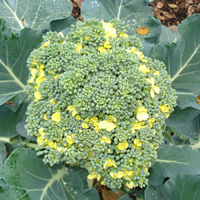Broccoli

The first broccoli seed in North America was sold by Stokes Seed Co., NY, in the 1920's. The crop has only been popular since World War II when the frozen food industry blossomed. Since then, many hybrids have been developed for the home garden with large compact central heads like one sees in the supermarkets.
Broccoli grows well in fertile, well-drained soil. It needs to grow rapidly without slowing down. Prepare soil deeply and with correct drainage. A soil on the acid side, below 6.5, can increase the susceptibility to club root disease, which can be misidentified as nematodes damage. Black rot, a very destructive bacterial disease, has previously been reported in the El Cajon area. Both bacterial and fungal diseases can stay in the soil for many years and this is why one should rotate Brassicas to different areas in the garden on a 2 to 4 year cycle.
Broccoli is a heavy feeder and soil should be supplied with a pre-plant fertilizer such as 16-20-0 or a slow release, balanced complete fertilizer formula. If organic methods are used, incorporate composted chicken manure and some bone meal or a blood meal and bone meal combination at least a few weeks before planting.
Broccoli is shallow-rooted and sometimes plants will blow over as they mature and become top heavy. Plant transplants up to the bottom set of leaves. This will place them a little deeper and prevent plants from leaning and forming a gooseneck stem. Never plant transplants that have a flower bud formed or ones with woody stems. Large transplants in six-packs at the nursery can be root-bound and under stress. Pass them up.
Space plants 12-18 inches apart depending on variety size and use wider spacing if furrow irrigating between rows. In raised beds, a staggered planting works well. Hand pull weeds under the shallow rooted plants.
Broccoli does very well under row covers fabric such as Reemay. Young transplants are shaded about 20% and insects are kept off until tissue is hardened. Row covers do not mean you can forget about what is going on underneath. A weekly inspection, at least, is a must for aphids or earlier deposited worm eggs beginning to hatch.
Row covers produce a microenvironments of warmth during the day. They reduce evaporation and provide protection from insects, birds and ground squirrels. Seedling can also be eaten by cutworms as soon as they are put out. Plants should have a paper collar wrapped around the stem as they are placed in the ground if you have had cutworm damage before.
Some microclimate areas can produce edible broccoli all summer long; but don't count on it if you garden out on the valley floor with lots of sun and hot air. As soil and air temperatures rise in the summer, broccoli becomes tough and of poor flavor. The cabbage butterfly lays eggs all summer and the bug problem can be more than the crop is worth compared to other seasonal vegetables in the summer.
Also check out ...
vric.ucdavis.edu/veg_info_crop/broccoli.htm
http://www.ipm.ucdavis.edu/PMG/selectnewpest.cole-crops.html
Planting Dates
Coastal:
Plants can be set out from September to February. Seeds can be planted from August to December.
Inland:
Plants can be set out from September to February. Seeds can be planted from August to October.
Varieties
There are other types grown in Europe and the Orient: the cauliflower-broccoli cross called Romanesco (85 days), and Floccoli (65 days), the green sprouting Broccoli raab (a turnip broccoli) and the Chinese broccoli which is actually a kale.
Most home vegetable gardeners like a plant that will produce a large central head, which after cutting, causes the plant to sprout many side shoots that can be harvested over a long season. Bonanza Hybrid (Burpee, 55 days) is a good one. There are several varieties called Sprouting Broccoli that do not form a large central head. These are probably one of the easiest Brassicas to grow: Early Purple Sprouting (120 days) and the old Italian variety Calabrese (85 days). If you want a large-headed type, one of the best is Premium Crop, an All-American Selection. Burpee, Park and Stokes all carry it. Do not forget that maturity dates listed here and in catalogues are from setting out the transplants in the spring. Also, for large head types, try Goliath & Packman.

